Telemedicine App Development: Your Complete Guide for 2022


Telemedicine implies the application of information technology solutions for facilitating communications within healthcare systems via interactive means so that remote patients get instant access to medical care services.
Telehealth apps appear to be the major supply channel of the medical enterprises that need specific telemedicine software for maintaining their level of medical care and management up to date.
As stated in Market Study on Telemedicine conducted by the European Commission, one of the kickstart accelerators of telemedicine apps development is the immense potential of the global well-being market segment.
Telemedicine Service in Numbers
According to Statista, the global telemedicine market was valued at $18 billion in 2015 and is expected to reach nearly 460 billion U.S. dollars by 2030. As the recent job postings illustrate, there is a huge demand for telemedicine service specialists, especially in the Departments of Radiology, Psychiatry, Neurology, Family Medicine, Dermatology, Pediatrics, and Allergy and Immunology.
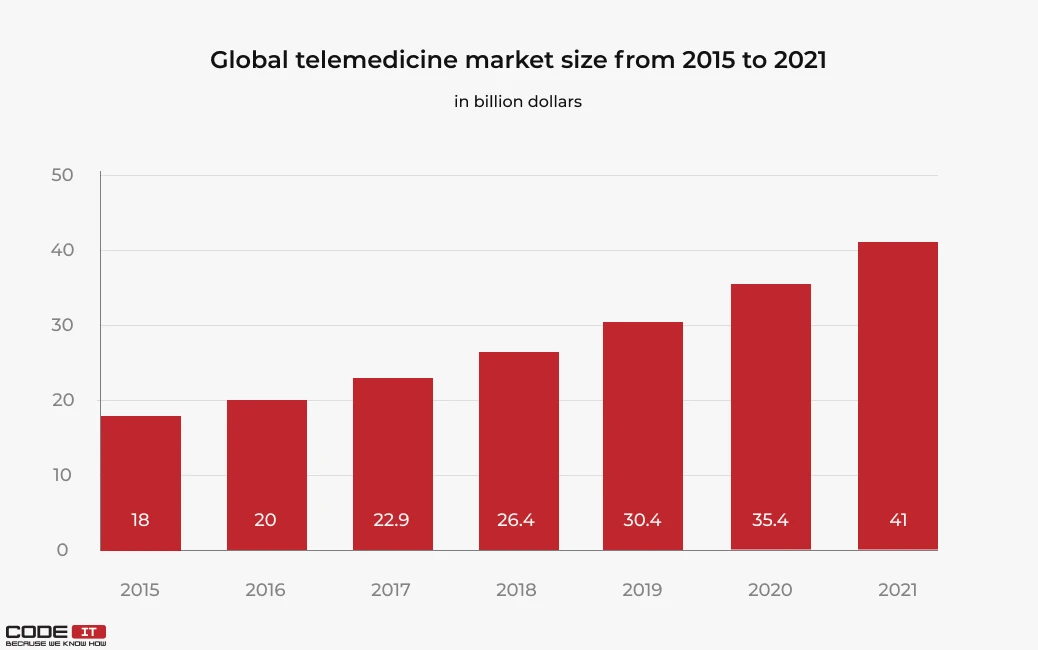
The adoption of telehealth technologies is so wide-reaching that hospitals either actively invest in implementing them within their inpatient facilities or plan to do so in the next 18 months.
In particular, the development of mobile telemedicine apps, which are trend-setters in paving new ways of communication between a doctor and a patient, demonstrates the steady growth with the expected annual rate of 35% in the next few years.
The complex functionality neatly packed in simple mobile interface design for delivering the best consumers’ experience allowed such apps as Doctor On Demand, LiveHealth, MDLive, Lemonaid, HealthTap to enjoy leadership positions in telehealth service.
Build a custom telemedicine app? Opt for:
Telemedicine Benefits
The benefits of telemedicine solutions are confirmed with the facts of their growing popularity among doctors and patients alike. Citing the authoritative source on telemedicine evolvement analysis: “From 2015–2018, Doximity found that the number of physicians who self-reported telemedicine as a skill doubled and continues to increase by approximately 20 percent per year. This correlates with significant growth in telemedicine patient visits, which increased annually by 261 percent between 2015 and 2017”.
Overall, in addition to opening new streamlined revenue channels for businesses, telemedicine apps improve healthcare and help achieve a number of significant goals.
- By applying telemedicine apps in rural areas, people living there got access to a better level of patient experience at a lower cost.
- The other groups of patients that benefit from applying telemedicine solutions are home-bound patients and elderly people for whom reaching the inpatient facilities on a frequent basis could be a challenge.
- The importance of telemedicine cannot be overrated due to considerably reducing the travel time and cost that patients would otherwise have to spend to reach health centers and wait in line.
- Speaking of the financial benefits of telehealth apps, it should be mentioned that telemedicine apps optimize service delivery making it affordable for patients.
- With telemedicine apps, service that under other conditions would require considerable time consumption is now easily accessible across any device. In general, it makes telemedicine invaluable at the stage of diagnosis and remote monitoring.
- And, finally, another reason for patients to use telemedicine is to obtain a second medical opinion by utilizing an online consultancy service.
Being a relatively new trend, the telemedicine software development market grows and changes from the ‘store and forward’ model that implied collecting, storing, and sending the data to specialists to the ‘tracking in real-time’ model that implies the active usage of medically purposed components synced with the mobile devices.
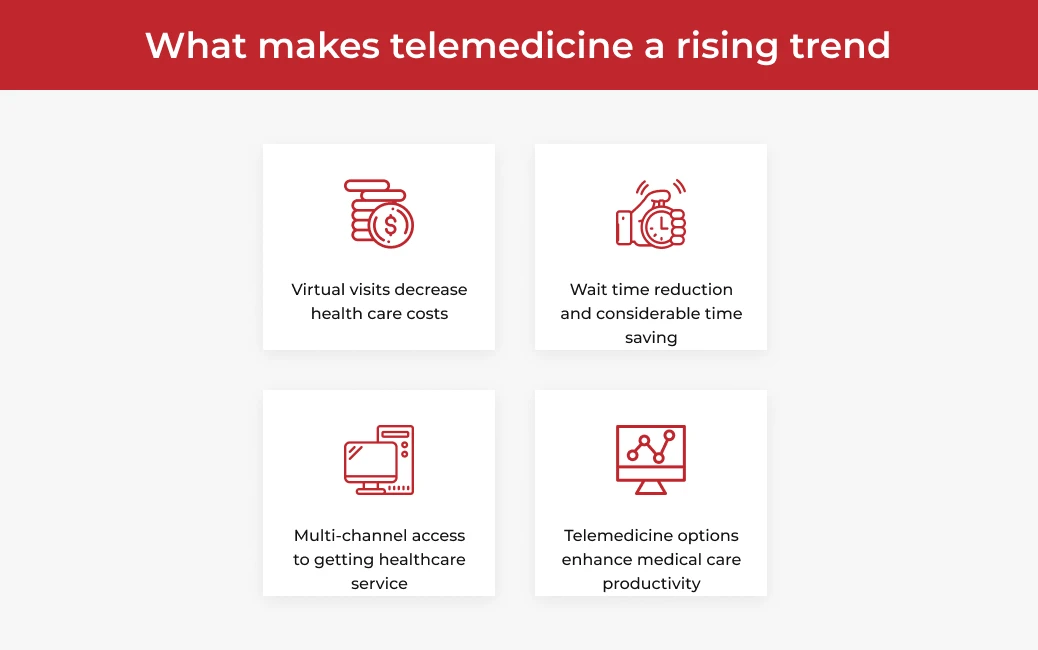
Taking into consideration the stated facts, it comes as no surprise that telemedicine app development is on the radar on many businesses growth plans because it perfectly incorporates within the digital environment of healthcare systems and shows a well-positioned tendency for engaging lots of categories of service recipients:
- Patients, especially those living in rural areas
- Doctors that need to fend time mismanagement off their schedule
- Health systems providers get the opportunity to automate admin routine and, thus, increase the patients’ intake and improve the quality of consumers’ medical care experience.
Telemedicine apps use cases
Telemedicine acts responsive upon incorporating it into various healthcare settings.
For instance, it became a routine case for the following procedures:
- Virtual visits and remote follow-ups (for addressing the patients’ questions and evaluating their condition for the cases when there is no urgent need for readmission to the hospital).
- Test results discussion (updating the patient with feedback on the test results).
- Video conferencing within providing real-time consultation to various categories of patients to improve treatment accuracy.
See how CodeIT successfully created a telemedicine platform for children
- Cloud-Based Consultations (for example, for burn injury care via smartphone application).
- Online appointments for providing medication advice (drug interaction, medication adjustment needs).
- Prescription renewal upon refill requests.
- Consultancy service for obtaining a second opinion of the diagnosis.
- Remote hospital operations.
The cases of telemedicine apps usage range from covering managerial functions aimed at improvement of the healthcare facilities business operations to address the specific needs of an individual patient.
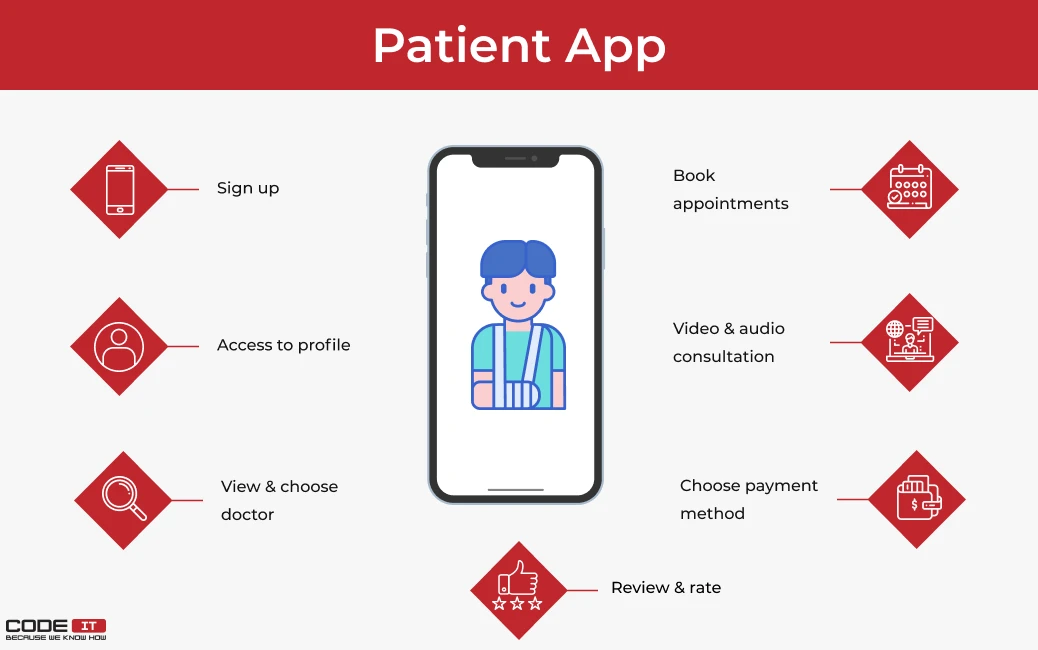
Here are features of telemedicine apps for patients that usually enable:
- Registration
- Identity authentication
- Browsing doctors
- Viewing doctors’ credentials
- Choosing a doctor
- Scheduling appointments
- Video/Audio online consultation
- Access to Profile and History
- Payment (as in most cases telemedicine is covered by insurance, the option of adding insurance provider details comes in handy)
Extra features that the telemedicine app for patients could include:
- Reviews for facilitating the optimal choice
- In-app chat (with or without webcam support)
- Telemedicine mobile app must include geolocation for providing the relevant data
- Cloud storage for keeping track of visits and communication backup
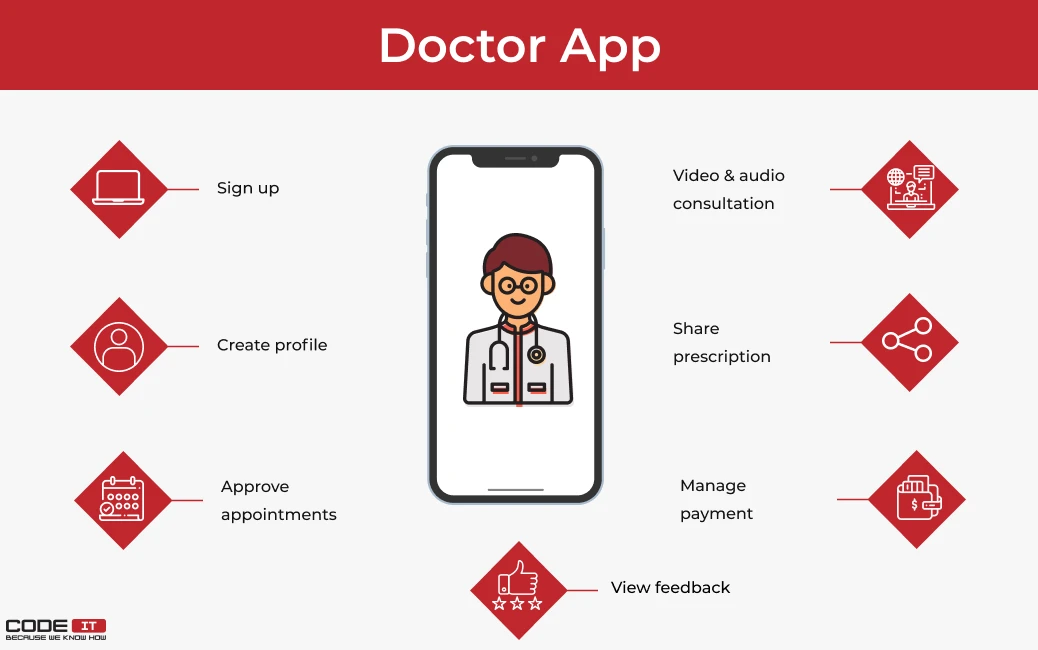
Telemedicine apps for doctors are marked with features that enable:
- Authentication
- Creating profile
- Scheduling/Rescheduling appointments
- Video/Audio online consultation
- Sharing prescription
- Getting feedback
- Answering queries
- Charging and collecting payment upon remote visit completion.
Other useful telemedicine app features for doctors could include:
- Expanding medical prescription database (with the function of adding detailed descriptions)
- Analytics dashboard
- Video session recording
Would you like to discuss the feature set for your telemedicine app?
Admin panel in telemedicine app template is marked with features that enable:
- Doctor management
- Patient management
- Reporting and Analytics to forecast and adjust the digital strategies
- Appointment management for workflow flexibility, reducing doctors’ overload, and increasing patients’ convenience
- Notification management for up-to-date communications.
- Integration with electronic health record software (EHR) for seamless scheduling
Challenges in Telemedicine App Development
As stated in telehealth history research: “…what really brought a stream of progress and innovation to the field was NASA’s funding of telemedicine projects throughout the 1960s and 1970s. As NASA tried to solve the complex problem of providing healthcare to astronauts in space, it also funded telemedicine projects around the country and even across the world”.
It means that the history of telemedicine apps dates back to the 1960s, and it could be expected that the benefits of apps usage considerably outweigh minor challenges that developers could face. Indeed, the idea of telehealth is appreciated both by patients and doctors.
But despite the rich history and healthcare executives’ encouragement to incorporate telemedicine apps in the medical facilities, it does not completely remove challenges of implementation because most often issues with telemedicine apps development pertain to complex technicalities that can be resolved with choosing the reliable custom software development provider.
Challenge #1: UI/UX
Creating the innovative software in telemedicine requires a unified solution for different platforms as one component of the app will be addressing the patients’ needs while the other component will be the doctors’ domain.
Why it’s important: The compatibility of two functionality sets, which will progress naturally, must become a major goal at the stage of planning the app’s interface.
Challenge #2: Back-end infrastructure
Another challenge when developing the telemedicine app pertains to backend integration that would enable mediating the data exchange between patients’ and doctors’ apps components.
Why it’s important: Integrating two complex systems is crucial as it allows to send or receive information instantly.
Telemedicine Application Features
As a rule, telemedicine apps are presented with the following components: doctor app, patient app, and admin panel.
Overall, service offerings that provide communications between a doctor and patient greatly vary and may include meetings streamlining, 24/7 access to certified specialists, consultancy on various health-related issues, etc.
For better understanding the core functionality of telemedicine apps, let’s explore in-depth those options of telemedicine software that address the specific users’ needs. Here are the standard features that you can find in any telemedicine app case study.
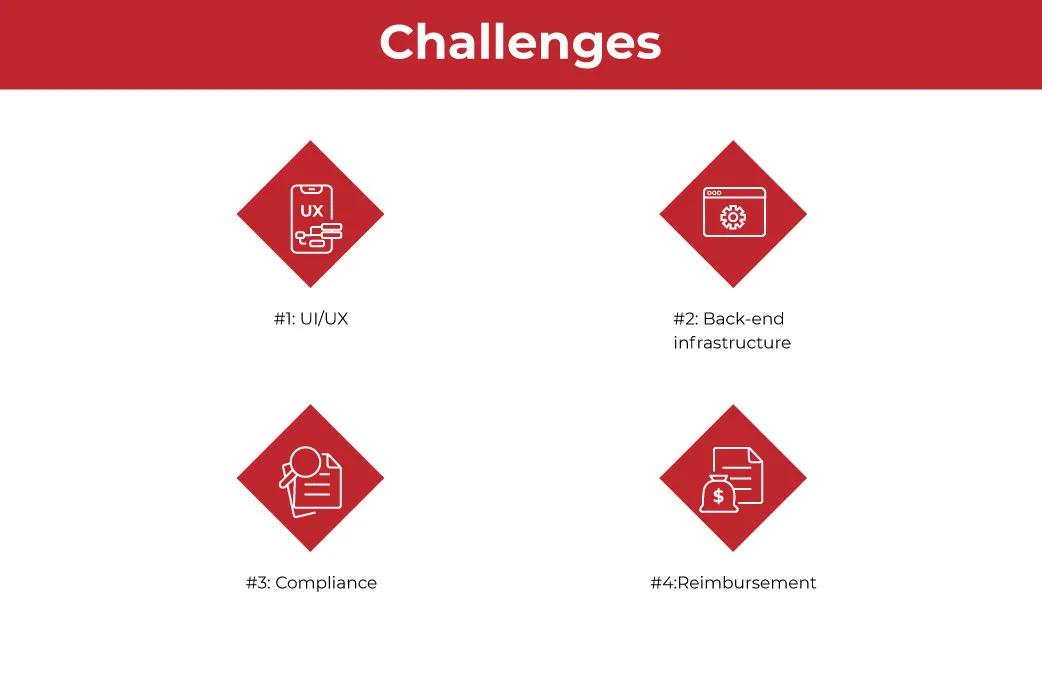
Challenge #3: Compliance
The HIPAA (Health Insurance Portability and Accountability Act) Privacy Rule sets standards of protection for individuals’ medical records in healthcare systems including telemedicine, which makes compliance to HIPAA security rule a question of high priority for apps developers. This is one of the challenges of creating the best telemedicine apps.
Why it’s important: Within the communication between the apps, due to the potential breaches of security and sensitive character of the exchanged data, there must be applied the most secure data exchange protocols with strict observance of all the HIPAA requirements.
Challenge #4: Reimbursement
Implementing telemedicine apps results in ‘switching on’ the numerous legalities. Mostly, users are provided with some reimbursement for telehealth encounters but its coverage differs depending on the laws and regulations of the states.
Why it’s important: Thus, some legislative initiatives are still in progress so physicians and patients can participate in virtual encounters but must be aware of the complex legal system behind the app’s usage.
Telemedicine during the COVID-19 outbreak
Initially, telemedicine solutions were created as a convenient means of connecting medical workers and people who live far from care centers, in the so-called rural areas, and for remote monitoring of people suffering from chronic diseases. With the advent of the Covid-19 pandemic into our lives, the role of telemedicine solutions has expanded. In conditions when a large number of people are simultaneously ill and require therapeutic diagnostics, hospitals are overcrowded, and personal offline contacts should be minimized, telemedicine applications have received a new influx.
It should be said that the foundations for the application of telemedicine solutions in a pandemic were laid and tested earlier. In 2003, with the SARS epidemic and in 2013 with the MERS-CoV epidemic. Therefore, after the declaration of Covid-19 as a pandemic in March 2020, medical professionals with previous experience with such solutions were able to balance the workload and continue to provide services to both regular non-Covid visitors and newly arrived patients with infectious diseases.
As expected, the telemedicine industry received a large inflow of investments and, according to some reports, the overall market growth exceeded the pre-Covid forecasts by 38 times. According to Pfizer CEO, it will be possible to completely curb the disease by about the end of 2022, taking into account the stable vaccination of all segments of the population. These facts have certainly slowed the growth of the telemedicine app development solutions market. However, a decline in investment inflows is not expected, as telemedicine solutions have proven their worth and usefulness during the pandemic, and remote care is an obvious trend for the coming years.
Concluding Thought
Delivering health care through telehealth apps is a trend on the rise due to various factors in favor of embracing technologies for opening new opportunities that telemedicine apps users welcome, and telemedicine growth statistics confirm it.
Besides benefits that doctors and health administrators get from telemedicine apps, telehealth service proves to be a patients’ best option as it enables hassle-free scheduling appointments, providing frequent consultations, meeting a doctor in the comfort of home and cutting down considerable amounts of money and time on transporting and waiting, which makes telemedicine apps development a promising sector on the healthcare software market.
FAQ
Telemedicine apps connect patients with doctors who provide consultation remotely via video chat. Telemedicine implies the application of information technology solutions for facilitating communications within healthcare systems via interactive means so that remote patients get instant access to medical care services.
Telemedicine apps are presented with the following components: doctor app, patient app, and admin panel. The features of the patient app can include searching and choosing a doctor, appointments scheduling, video/audio online consultation, payment, etc.
The development of a telemedicine application requires research, analysis, design, stating the feature list, choosing the tech stack, and the development stage with the following testing and maintenance. Looking to the answer of how to build a telemedicine system question? Choose the right telemedicine app development company since it is a key factor for project success.
The cost of telemedicine app greatly depends on the choice of platform for the development, feature set complexity, developers’ rates, tech stack. The timeline for this development varies from approximately 3 to 6 months. To have detailed information, contact us at [email protected], and we will provide free consultation on a cost estimate of your project.
Telehealth and telemedicine solutions are an obvious trend for the coming years. In the future, people will not need to meet offline with healthcare professionals to receive care. Remote medicine will allow doctors to provide faster care to more people without the risk of additional harm to health. And these are the three main benefits of this technological trend.
Of course, the mobile telemedicine applications are perhaps the most convenient and best way to contact a doctor and receive medical care and consultations.
Build your ideal
software today







